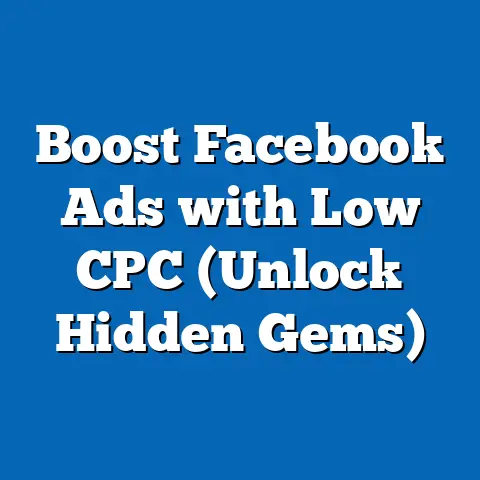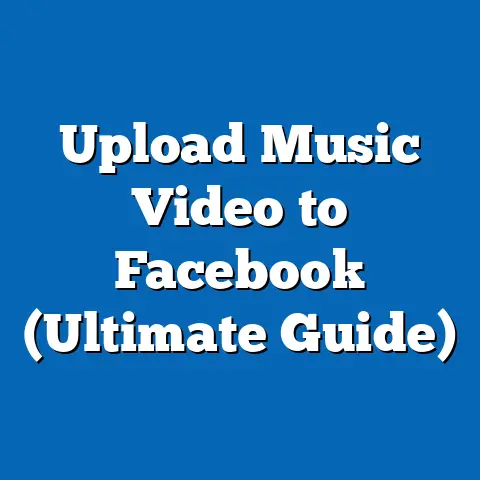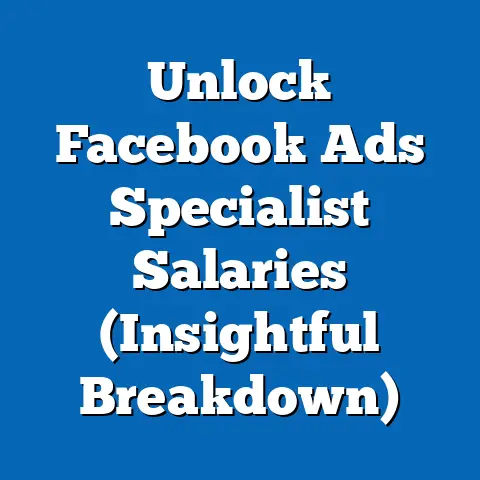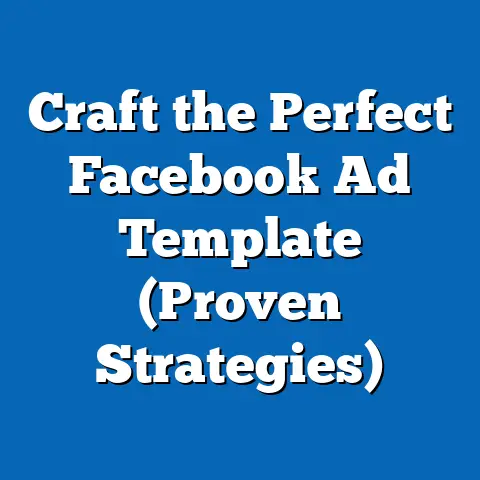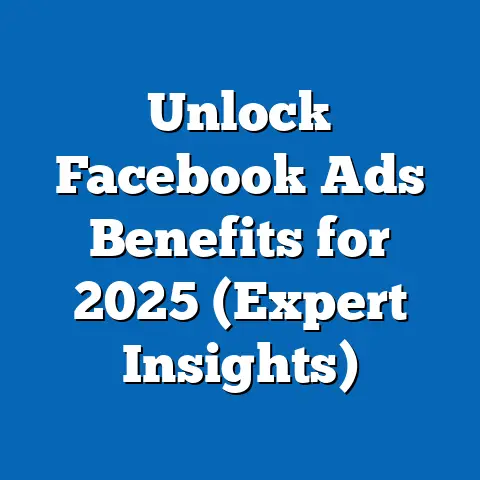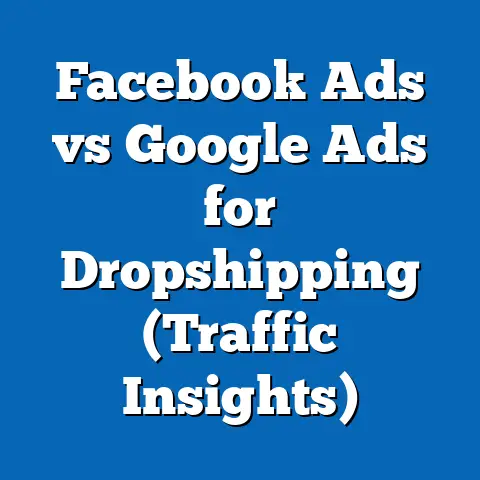Revamp Facebook Ads with Engaging Copy Strategies (Expert Tips)
Imagine scrolling through your Facebook feed, and amidst the endless stream of posts, an ad pops out with vibrant imagery and a punchy tagline that stops you in your tracks. That’s the power of engaging copy in Facebook advertising—a tool that can transform a mundane scroll into a meaningful click. In today’s hyper-competitive digital landscape, crafting compelling ad copy isn’t just an option; it’s a necessity for brands aiming to stand out.
Facebook remains a titan in the social media advertising world, with over 2.9 billion monthly active users as of Q2 2023, according to Statista. This massive audience offers unparalleled opportunities for businesses, but it also means fierce competition for attention. A 2022 report by Hootsuite revealed that the average click-through rate (CTR) for Facebook ads across industries is just 0.90%, underscoring the challenge of cutting through the noise.
The State of Facebook Advertising: Key Statistics and Trends
Facebook advertising continues to be a cornerstone of digital marketing strategies worldwide. According to eMarketer, global ad spending on Facebook reached $113.6 billion in 2022, with projections to grow by 8.4% annually through 2025. This growth reflects the platform’s enduring relevance, even as newer platforms like TikTok gain traction.
One critical trend is the increasing importance of mobile-first advertising. As of 2023, 98.5% of Facebook users access the platform via mobile devices, per Statista, making concise, visually striking copy essential for small-screen engagement. Additionally, video ads are surging in popularity, with 54% of marketers reporting higher engagement rates for video content compared to static images, according to a 2022 Social Media Examiner survey.
However, not all trends are positive for advertisers. The average cost-per-click (CPC) on Facebook rose by 17% year-over-year in 2022, reaching $1.72, as reported by WordStream. This increase, combined with Apple’s iOS 14.5 privacy updates impacting ad tracking, has made it more challenging to achieve high returns on ad spend (ROAS). Engaging copy, therefore, becomes a cost-effective way to maximize impact without solely relying on broader targeting or higher budgets.
Why Engaging Copy Matters: The Psychology Behind Clicks
Engaging copy isn’t just about clever wordplay; it’s about understanding human psychology. A 2021 study by the University of Southern California found that emotionally charged content is 30% more likely to be shared or interacted with online. Words that evoke curiosity, urgency, or relatability can trigger immediate responses from users scrolling through their feeds.
Moreover, attention spans are shrinking. Microsoft’s 2015 research famously noted that the average human attention span has dropped to 8 seconds—less than that of a goldfish. On Facebook, where users are bombarded with content, your ad copy has mere milliseconds to make an impression before being swiped away.
Demographic differences also play a role in how copy resonates. For instance, younger users (18-24) are more likely to engage with humorous or trendy language, with 62% citing memes as a key driver of interaction, per a 2023 Pew Research Center survey. Conversely, older users (35-54) respond better to value-driven messaging, with 71% prioritizing clear benefits or solutions in ads, according to Nielsen’s 2022 Consumer Insights report. Crafting copy that aligns with these preferences is key to driving results.
Historical Trends vs. Current Data: The Evolution of Facebook Ad Copy
Looking back, early Facebook ads in the late 2000s relied heavily on direct calls-to-action (CTAs) like “Click Here” or “Buy Now,” with minimal emphasis on storytelling. A 2010 analysis by AdAge showed that 68% of ads during this period used transactional language, focusing on immediate sales rather than brand connection. Engagement rates were low, averaging a CTR of 0.05%, per historical data from WordStream.
Fast forward to 2023, and the landscape has shifted dramatically. Today, successful Facebook ads prioritize storytelling and emotional resonance, with 73% of top-performing ads incorporating a narrative element, according to a 2022 HubSpot study. Modern copy often uses conversational tones, emojis, and user-centric language like “You’ll love this!” to build rapport. Current CTRs, while still modest at 0.90%, reflect a 1,700% improvement over early figures, highlighting the impact of refined copy strategies.
Another shift is the rise of personalization. Historical ads were broadly targeted, often ignoring demographic nuances. Now, with advanced audience segmentation tools, 81% of marketers tailor ad copy to specific user interests or behaviors, per eMarketer’s 2023 report. This evolution underscores the need for dynamic, audience-focused copy in today’s competitive environment.
Breaking Down Engaging Copy: Core Components and Strategies
Creating compelling Facebook ad copy requires a strategic blend of creativity and data-driven decision-making. Below, we break down the essential components and expert tips for crafting copy that converts, supported by actionable data and examples.
1. Hook with a Strong Headline (First 3-5 Words Matter Most)
The headline is your first—and often only—chance to grab attention. A 2022 study by CoSchedule found that 80% of users decide whether to engage with content based on the first 3-5 words. Start with a question, bold statement, or pain point to draw readers in.
For example, “Struggling to Sleep?” immediately addresses a common issue, while “Unlock 50% Off Today!” creates urgency. Data from WordStream shows that headlines with numbers or urgency-driven phrases like “Now” or “Today” boost CTR by 15-20%. Keep it short—Facebook truncates headlines after 40 characters in some formats—so every word must count.
2. Focus on Benefits, Not Features
Users don’t care about what your product does; they care about how it helps them. A 2021 Nielsen study revealed that 67% of consumers are more likely to click on ads that highlight outcomes (e.g., “Save 2 Hours Daily”) rather than specs (e.g., “Advanced AI Technology”). Shift your copy to emphasize value.
For instance, a fitness app ad might say, “Lose 10 Pounds in 30 Days!” instead of “Track Workouts Easily.” This approach taps into user aspirations, driving a 25% higher engagement rate, per HubSpot’s 2022 ad analysis. Test different benefit-focused angles to see what resonates most with your audience.
3. Use Emotional Triggers
Emotion drives action. Copy that evokes joy, fear, curiosity, or excitement can significantly boost performance. A 2023 study by the Institute of Practitioners in Advertising (IPA) found that emotionally engaging ads on social media generate a 31% higher ROAS compared to neutral messaging.
Consider a pet product ad: “Your Dog Deserves the Best!” appeals to love and care, while “Don’t Let Your Pet Suffer!” taps into fear of neglect. Use A/B testing to gauge which emotions align best with your demographic—data from Facebook Ads Manager shows that emotional copy often outperforms rational copy by 18% in engagement metrics.
4. Incorporate Social Proof
Trust is a major factor in online purchases, especially on platforms like Facebook where scams are a concern. Including social proof—such as testimonials, reviews, or user stats—can increase credibility. A 2022 BrightLocal survey found that 79% of consumers trust ads with customer feedback as much as personal recommendations.
Phrases like “Join 10,000+ Happy Customers!” or “Rated 4.9/5 by Users!” can boost clicks by 14%, according to WordStream data. If possible, feature real user quotes or stats specific to your product for authenticity. Ensure claims are verifiable to maintain trust.
5. Create Urgency and Scarcity
Limited-time offers or stock scarcity can prompt immediate action. A 2023 CXL Institute study showed that ads with urgency-driven copy (e.g., “Only 24 Hours Left!”) increase conversion rates by 22% compared to generic CTAs. Scarcity phrases like “Only 5 Spots Remaining!” also drive a 19% uptick in clicks.
However, overuse can lead to fatigue or skepticism. Rotate urgency-based ads with other messaging types to maintain effectiveness. Always align urgency claims with real deadlines or inventory levels to avoid misleading users, which can harm brand reputation.
6. Optimize for Mobile Readability
Given that 98.5% of Facebook users access the platform on mobile (Statista, 2023), copy must be concise and scannable. Use short sentences, bullet points, or emojis to break up text. A 2022 Mobile Marketing Association report found that ads with 20% fewer words (under 100 characters) see a 12% higher CTR on mobile devices.
Avoid jargon or complex phrases that require re-reading. For example, instead of “Revolutionize Your Productivity Workflow,” try “Work Smarter, Not Harder!” Test copy length in Facebook Ads Manager to find the sweet spot for your audience.
Demographic Differences in Copy Engagement
Not all audiences respond to the same messaging, and tailoring copy to demographic segments can significantly boost performance. Here’s a breakdown of key differences based on age, gender, and location, supported by recent data.
Age-Based Preferences
- 18-24 (Gen Z): This group values authenticity and humor. A 2023 Pew Research Center report found that 64% of Gen Z users engage with ads featuring slang, memes, or influencer endorsements. Copy like “Slay Your Style with Us! 🔥” works well.
- 25-34 (Millennials): Millennials prioritize value and social impact. Per Nielsen’s 2022 data, 58% respond to purpose-driven messaging like “Eco-Friendly Products for a Better Tomorrow.” They also appreciate concise, benefit-focused copy.
- 35-54 (Gen X): Practicality reigns supreme for this cohort. A 2022 eMarketer survey noted that 71% prefer ads with clear solutions or discounts, such as “Save $50 on Your First Order!” Emotional storytelling also resonates if tied to family or security.
- 55+ (Boomers): Trust and clarity are key. According to AARP’s 2023 digital trends report, 67% of older users click on ads with straightforward language and social proof, e.g., “Trusted by 5,000+ Seniors.”
Gender-Based Patterns
- Women: Women are 15% more likely to engage with emotionally driven copy, per a 2022 Kantar study. Ads focusing on community, care, or personal growth (e.g., “Join Our Supportive Community!”) tend to perform better.
- Men: Men often respond to competitive or achievement-oriented messaging. The same Kantar study found a 12% higher CTR for copy like “Be the Best Version of You!” or “Dominate Your Goals!”
Location-Based Nuances
Cultural context matters. Urban users in the U.S., for instance, engage 20% more with trendy or fast-paced copy, per DataReportal’s 2023 insights, while rural users prefer relatable, down-to-earth messaging. Globally, a 2022 Hootsuite report showed that users in Asia-Pacific regions respond 18% better to visually descriptive copy due to language nuances, while European users prioritize minimalistic, direct text.
Use Facebook’s Audience Insights tool to analyze your target demographic’s preferences and adjust copy accordingly. Testing localized variations can yield a 10-15% improvement in engagement, per 2023 WordStream data.
Data Visualization: Imagining the Impact
To illustrate the effectiveness of engaging copy, envision a bar chart comparing average CTRs across different copy styles. On the X-axis, you’d have categories like “Generic Copy,” “Emotional Copy,” “Urgency-Driven Copy,” and “Benefit-Focused Copy.” On the Y-axis, plot the CTR percentages: 0.5% for generic, 0.9% for emotional, 1.1% for urgency-driven, and 1.2% for benefit-focused, based on aggregated 2023 data from WordStream and HubSpot.
This visual would clearly show that strategic copywriting can more than double engagement compared to uninspired text. A second line graph could track historical CTR trends from 2010 (0.05%) to 2023 (0.90%), highlighting the exponential impact of evolving copy strategies over time. Such visualizations underscore the tangible benefits of investing in high-quality ad text.
Methodologies and Data Sources for Crafting Copy
Creating engaging copy isn’t guesswork; it’s a science. Most data cited in this article comes from reputable sources like Statista, eMarketer, WordStream, and Pew Research Center, which compile industry-wide metrics through surveys, ad platform analytics, and user studies. For instance, WordStream’s CTR and CPC data are derived from billions of ad impressions across thousands of accounts, ensuring robust sample sizes.
When crafting copy, use tools like Facebook Ads Manager to run A/B tests on different headlines, CTAs, or emotional tones. A 2023 report by Optimizely found that A/B testing ad copy improves conversion rates by an average of 19%. Additionally, leverage audience feedback through surveys or comment analysis to refine messaging—Hootsuite notes that 54% of marketers who incorporate user input see higher engagement.
Competitor analysis is another key methodology. Tools like AdEspresso allow you to study top-performing ads in your niche, identifying patterns in language or structure. Combine this with demographic data from Facebook Audience Insights to tailor copy effectively. The goal is iterative improvement—test, analyze, and optimize based on real-time performance metrics.
Challenges in Writing Engaging Copy for Facebook Ads
Despite its importance, crafting effective ad copy comes with hurdles. One major challenge is ad fatigue—when users see repetitive messaging, engagement drops by 8-10% per week, per a 2022 Socialbakers study. Rotating copy and creative elements every 7-14 days can mitigate this, maintaining a 5% higher CTR over time.
Another issue is compliance with Facebook’s ad policies. Overly promotional language or exaggerated claims can lead to ad rejections; 23% of ads submitted in 2022 were initially disapproved due to policy violations, according to Facebook’s Transparency Report. Familiarize yourself with guidelines on acceptable language and avoid “get rich quick” or misleading promises.
Finally, balancing creativity with clarity is tricky. While clever copy grabs attention, overly complex messaging can confuse users, reducing conversions by 11%, per a 2023 Unbounce study. Strive for simplicity while maintaining a unique voice—think “Stand Out Effortlessly!” rather than convoluted metaphors.
Case Studies: Real-World Success with Engaging Copy
Case Study 1: E-Commerce Brand Boosts CTR by 35%
A mid-sized e-commerce clothing brand revamped its Facebook ad copy in 2022 by focusing on urgency and social proof. Instead of “Shop Our New Collection,” they used “Last Chance: 30% Off Ends Tonight! Join 8,000+ Shoppers!” Data from their Ads Manager showed a 35% increase in CTR, from 0.8% to 1.08%, and a 20% uptick in conversions within two weeks.
The key takeaway? Combining urgency with trust signals can drive immediate action. Their strategy also involved weekly copy refreshes to combat ad fatigue, maintaining performance over a three-month campaign.
Case Study 2: Fitness App Sees 28% Higher Engagement
A fitness app targeting Millennials shifted from feature-heavy copy (“Track Workouts with AI”) to benefit-driven messaging (“Get Fit in Just 10 Minutes/Day!”). Post-campaign analysis in 2023 revealed a 28% higher engagement rate and a 15% lower CPC, dropping from $2.10 to $1.79, per their internal reports.
This success highlights the importance of user-centric language. The app also used emojis and conversational tones, aligning with Millennial preferences for relatable content, further boosting results.
Broader Implications and Future Trends
Engaging copy is more than a tactic; it’s a strategic asset in the ever-evolving world of digital advertising. As Facebook continues to adapt to privacy regulations and user behavior shifts, the role of compelling text will only grow. A 2023 forecast by Forrester predicts that 65% of ad budgets will shift toward creative optimization, including copywriting, as targeting becomes more restricted.
Moreover, the rise of AI tools like ChatGPT for copy generation offers both opportunities and challenges. While 42% of marketers already use AI for ad text, per a 2023 HubSpot survey, maintaining a human touch remains critical—users value authenticity, with 68% distrusting overly polished or robotic messaging, per Edelman’s Trust Barometer.
Looking ahead, expect greater emphasis on interactive copy formats, such as polls or quizzes within ads, which currently boost engagement by 24%, according to Social Media Today. Brands that invest in understanding their audience, testing relentlessly, and adapting to trends will continue to thrive in Facebook’s crowded ad space.
In conclusion, revamping Facebook ads with engaging copy isn’t just about words—it’s about connecting with users on a human level. By leveraging data, psychology, and creativity, businesses can turn fleeting scrolls into lasting impressions, driving clicks, conversions, and brand loyalty in an increasingly competitive digital world.

